Paleochristian art : The most interesting example of Paleochristian art and unique in Italy is the 'Codex Purpureus', which arrived in Calabria between the 6th and 7th centuries AD , probably in the wake of the Basilian migration. It is, however, much older. Though it did not originate here, but was simply conserved in the region, it is important as indicative of a movement of thought.
Now in the Rossano Diocesan Museum ( Cosenza ), the 'Codex consist of 188 purple parchment sheets with parts of the Gospel according to St. Mark and the whole of St. Matthew in Greek letters, with twelve miniatures of the life of Jesus. Rossano a real treasure trove of art, also has the fresco of the Madonna Archeropita ( in the Cathedral ) a Byzantine work of uncertain date.
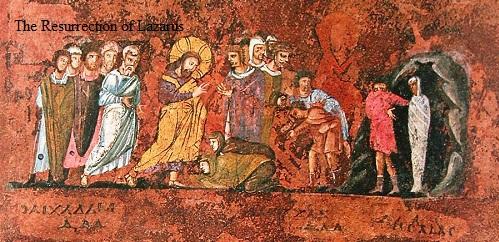 |
Byzantine influence : Western Europe has been decisively influenced by Celtic and Eastern cultures, but whereas the Celtic element is completely absent from Calabria, the region has been strongly influenced by the East in its arts, though this cannot be said for sculpture, condemned at the Council of Nicea as ungodly .
Artistic efforts were thus, directed to painting and architecture, the latter exclusively Basilian.
Very ancient examples of church architecture are found in Calabria.
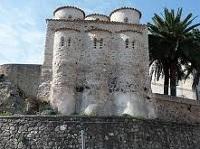 The small 10th or 11th century church of San Marco di Rossano has a rectangular vestibule and a large square place divided by six pillars. Three semi-circular apses and double arched windows complete the building.
The small 10th or 11th century church of San Marco di Rossano has a rectangular vestibule and a large square place divided by six pillars. Three semi-circular apses and double arched windows complete the building.
The church of the Panaghia is slightly later ( mid-12th century ) and has a semi-circular apse with external cotto decoration. The little church on Monte Marco, at Cassano allo Ionio , the Annunziatella at Gerace ( in ruins ) and especially the Cattolica di Stilo, all belong to this period.
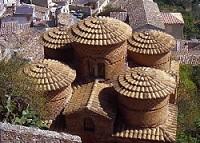 Situated on a hill in the middle of the countryside, this latter church is a kind of early Christian Acropolis with architectural elements similar to those of Greek, Armenian and Anatolian churches.
Situated on a hill in the middle of the countryside, this latter church is a kind of early Christian Acropolis with architectural elements similar to those of Greek, Armenian and Anatolian churches.
Built of red brick, it is square with three similar round apses, three double arched windows and five small domes, one in each corner and the largest in the centre, decorated with square bricks in a spiral pattern.
Four columns with capitals (perphas from Greek temples) divide the interio into three naves.
Traces of frescoes can still be seen and one column has Greek inscription. The little church of Spedale di Scalea belongs to the same period.
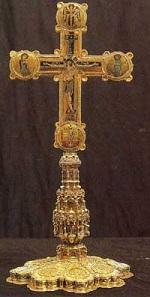 Of the 12th century objects, the most precious in the region is the Stauroteca, a reliquary of the Cross from the Swabian workshops in Palermo (c.1220) donated to Cosenza Cathedral by Frederick of Swabia, who was present at the consecration of the church. The cross is made of filagreed sheet gold with enamel and gemstones.
Of the 12th century objects, the most precious in the region is the Stauroteca, a reliquary of the Cross from the Swabian workshops in Palermo (c.1220) donated to Cosenza Cathedral by Frederick of Swabia, who was present at the consecration of the church. The cross is made of filagreed sheet gold with enamel and gemstones.
Norman Times : One would not expect to find typical Norman architecture in Calabria, since the Basilian style preveiled here, and the mingling of styles makes exact dating difficult to achive.
The Roccelletta of Bishop of Squillace, built in the wake of French Romanesque, is dated to the end of the 12th century.
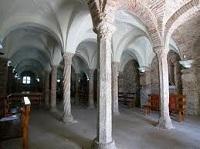 Other small but beautiful churchus include Umbratico Cathedral, with its twelve-columned crypt and cross-vaulted ceiling, the church of S.Adriano and S Demetrio Corona ( Cosenza ), noted for its Italo-Albanian College, in the Sila Greca. The church has a mosaic floor and frescoes.
Other small but beautiful churchus include Umbratico Cathedral, with its twelve-columned crypt and cross-vaulted ceiling, the church of S.Adriano and S Demetrio Corona ( Cosenza ), noted for its Italo-Albanian College, in the Sila Greca. The church has a mosaic floor and frescoes.
The Monastery of Sambucina was founded later at Luzzi ( Cosenza ) and built by the Benedectines, with the encouragement of the Abbey of Cava , which had many monks under its jurisdiction, also in Calabria.
This is a beautiful spot, surrounded by wood-land at height of 800 m ( in the Sila Greca ),and a fine view can be had from the road which passes above it. Characteristics are the festivals held here in costumes in August.
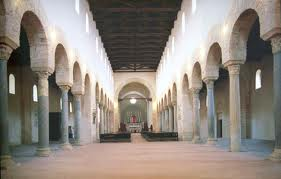 The greatest Norman building however, is Gerage Cathedral (Reggio di Calabria ), the biggest church in the region. Built in the form of a Latin cross, it measures 76 x 23 m and was consecrated in 1045.
The greatest Norman building however, is Gerage Cathedral (Reggio di Calabria ), the biggest church in the region. Built in the form of a Latin cross, it measures 76 x 23 m and was consecrated in 1045.
A double row of marble columns, perhaps from a nearby Locri temple, divides the interior into three large naves. The two altars are Baroque. Of considerable interest is the crypt, which can be intered from inside and outside the cathedral.The cross-vaukted ceiling is supported by 26 columns, several towards the door other parallel to the cathedral steps.
Another attractive feature of the crypt is the Itria Chapel ( late 12th C, restored ) ; the great wrought-iron gate dates to 1670.
During Norman times, the monks worked at making illuminated manuscript, and many of the illuminated codexes now found in European libraries come from Calabria.
The Swabian, Angevin and Aragon Periods : Frederick II built himself many fine buildings: the remains of his castle at Cosenza, destroyed by an earthquake in 1184, can still be admired, and Angevin and Bourbon traces are visible.
The Cathedral bears the stamp of the Cistercian building: simple and severe, and is said to be the work of Luca Campano, a Cistercian monk from Casamari. Various pieces belonging to this period are in the Cathedral, the most 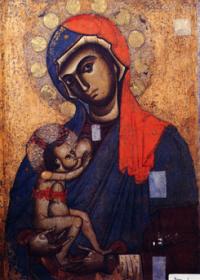 important being the icon of the Madonna di Pilero (a copy, the original is in the Archbishop's palace ), a masterpice by Eastern goldsmiths, and the sarcophagus of Isabella of Aragon, wife of Philip III, who died in Cosenza while returning from the East. This sarcophagus was made in France by French craftsmen. The most outsting example of Gothic art in a religious building is to be found at Altomonte ( Cosenza ) in the church of Santa Maria della Consolazione, built in c.1330 by Filippo Sangineto, the feudal overlord.
important being the icon of the Madonna di Pilero (a copy, the original is in the Archbishop's palace ), a masterpice by Eastern goldsmiths, and the sarcophagus of Isabella of Aragon, wife of Philip III, who died in Cosenza while returning from the East. This sarcophagus was made in France by French craftsmen. The most outsting example of Gothic art in a religious building is to be found at Altomonte ( Cosenza ) in the church of Santa Maria della Consolazione, built in c.1330 by Filippo Sangineto, the feudal overlord.
Though partly ruined, the basically Angevin structure remains. The Altomonte edifice, together with the castle, indicate how the local commission of buildings started, not only in large towns and villages but also in outlying areas.
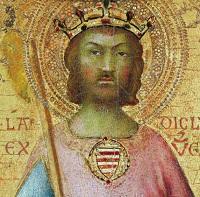 The S. Ladislao di Ungheria by Simone Martini , for centuries in Altomonte Cathedral, now in the Soprintendenza di Cosenza, was probably commissioned of the Sienese painter by Filippo Sangineto in 1326. Other paintings in the church are by B. Daddi and Ciccio da Mileto, a pupil of Antonello. Another monument a Tropea Cathedral, variously restored.
The S. Ladislao di Ungheria by Simone Martini , for centuries in Altomonte Cathedral, now in the Soprintendenza di Cosenza, was probably commissioned of the Sienese painter by Filippo Sangineto in 1326. Other paintings in the church are by B. Daddi and Ciccio da Mileto, a pupil of Antonello. Another monument a Tropea Cathedral, variously restored.
On the castles, Rocca Imperiale Castle ( Cosenza ) perhaps built by Swabians was completely reconstructed in 1400.There is also a castle by the sea at Roseto Capo Spulico ( Cosenza), altered under Charles of Anjou.
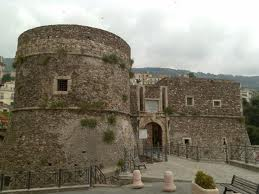 The famous Pizzo Castle (Aragonese ), where Murat was shot, was built at a later date. Belvedere Marittima Castle ( Cosenza ) is also Aragonese and fairly conserved. In this period, local craftsmen began to carry out the work, drawing inspiration from models imported to into Italy, particularly Catalonian.
The famous Pizzo Castle (Aragonese ), where Murat was shot, was built at a later date. Belvedere Marittima Castle ( Cosenza ) is also Aragonese and fairly conserved. In this period, local craftsmen began to carry out the work, drawing inspiration from models imported to into Italy, particularly Catalonian.
There are many examples of local work at Cosenza, in the quarter between the Church of St. Francis of Assisiand the Via Telesio, a mixture of elegant buildings ( Casa Ciaccio, Gaeta Sambiase ) with porticoes, wells, elaborate balconies, doorways with lowered Durazzo style arches and modest houses with outside stairways and pergolas.
Another interesting nearby zone is the Giudecca, where the early Jewish community was estabilished. Worthy of note here are the Sersale, Falvo and Martirano buildings, as well as those in via Padolisi.
The cloister of the restored church of St. Francis of Assisi dates to this period, like the church of S. Domenico. The great sanctuary of San Francesco di Paola in Renaissance style, at Paola ( Cosenza ) was founded by the saint himself, founder of the Order of the Minimi.
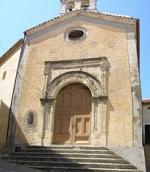 In Cosenza are the 16th century church of S. Chiara, annexed to the Library ( it has a dine wodden ceiling ), the church of the Virgins, with a tufa doorway, and decoration, the little church of S. Salvatore, with a triumphal arch dating to 1571 ( now the Albanian parish ) and the church of Madonna del Carmine with its convent, now the Carabinieri headquarters.
In Cosenza are the 16th century church of S. Chiara, annexed to the Library ( it has a dine wodden ceiling ), the church of the Virgins, with a tufa doorway, and decoration, the little church of S. Salvatore, with a triumphal arch dating to 1571 ( now the Albanian parish ) and the church of Madonna del Carmine with its convent, now the Carabinieri headquarters.
At Aieta ( Cosenza ) the fine Palazzo Cosentini is partly in ruins, but the interesting facade, wrought iron banister and decorated cornice are still to be seen; the doorway dates back to a later period.
Architectural styles in Calabria are slightly out of line with the rest of Italy, chronologically speaking, due to the difficulty in communication with other areas, and an innate sense of economy and attachment to one's native village; many building have been rebuilt rather then restored on the sane site, materials salvaged from other constructions, often those damaged by landslide and earthquakes.
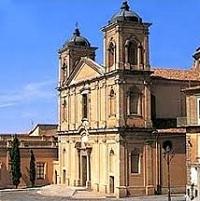 Baroque, in the 17th century began to spread all over Italy, especially to Naples , here in rather ambiguous lines.The best examples are Vibo Cathedral, built over an old Byzantine church, to a plan at least partly designed by Curatoli; in San Giorgio Martire, at Pizzo, St Francis of Assisi at Cosenza ( the interior), the Oratorio del Rosario, at San Domenico (the church is 15th century), and in the oratory of the Congrega del Rosario, Catanzaro, one of the rarest and most artistic works of local craftsmen is a wodden series consisting of choir, cerimonial chair, two choir lofts; there are also stucco wall decorations.
Baroque, in the 17th century began to spread all over Italy, especially to Naples , here in rather ambiguous lines.The best examples are Vibo Cathedral, built over an old Byzantine church, to a plan at least partly designed by Curatoli; in San Giorgio Martire, at Pizzo, St Francis of Assisi at Cosenza ( the interior), the Oratorio del Rosario, at San Domenico (the church is 15th century), and in the oratory of the Congrega del Rosario, Catanzaro, one of the rarest and most artistic works of local craftsmen is a wodden series consisting of choir, cerimonial chair, two choir lofts; there are also stucco wall decorations.
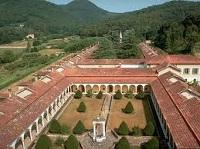 One of the best examples is the Montalto Uffugo Cathedral (Cosenza), with a sculptured limestone facade and portals elegantly carved by local sculptors, and wide flight of steps. The 16th century church of S. Francesco stands in the same square. The most striking example of the period is the Certosa di Serra San Bruno (Catanzaro) on the Ionian side of the Serre, in a splendid position. Founded by San Brunone in 1091, and restored inn the 16th century, it was destroyed by the earthquake of 1783. The facade and part of the 16th century cloisters still remain. It is said the Palladium designed the church. The visitor is impressed by the beauty of its site on alawn in the middle of woodland, at a heigth of 800 m, and by the facade resembling the background for a Spanish drama, calling to mind another, intact facade in Spain: Gaudi's Sacrada Familia (1900) in Barcellona.
One of the best examples is the Montalto Uffugo Cathedral (Cosenza), with a sculptured limestone facade and portals elegantly carved by local sculptors, and wide flight of steps. The 16th century church of S. Francesco stands in the same square. The most striking example of the period is the Certosa di Serra San Bruno (Catanzaro) on the Ionian side of the Serre, in a splendid position. Founded by San Brunone in 1091, and restored inn the 16th century, it was destroyed by the earthquake of 1783. The facade and part of the 16th century cloisters still remain. It is said the Palladium designed the church. The visitor is impressed by the beauty of its site on alawn in the middle of woodland, at a heigth of 800 m, and by the facade resembling the background for a Spanish drama, calling to mind another, intact facade in Spain: Gaudi's Sacrada Familia (1900) in Barcellona.
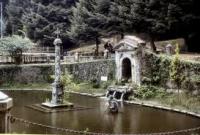 Close by stands the new monastery. Some 3 km further on, along a fir-lined road, lies the little church of Santa Maria del Bosco, where San Brunone died, the big hollow boulder (restored) where the saint prayed, and a small lake with a statue of San Brunone at prayer in the water. Legend has it that when his bones were being moved, a spring gushed forth. In the 16th century, the Gaginis, Sicilian sculptors and the Mazolas from Tuscany, were very active here.
Close by stands the new monastery. Some 3 km further on, along a fir-lined road, lies the little church of Santa Maria del Bosco, where San Brunone died, the big hollow boulder (restored) where the saint prayed, and a small lake with a statue of San Brunone at prayer in the water. Legend has it that when his bones were being moved, a spring gushed forth. In the 16th century, the Gaginis, Sicilian sculptors and the Mazolas from Tuscany, were very active here.
F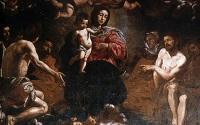 rom the 17th to the 19th century: Painting in Calabria was prevalently influenced by Mannerism, and this is the style found in the Madonna of Ognissanti (from Stilo Cathedral), now at the Laboratorio di Conservasione della Soprintendenza at Battistello Caracciolo (Cosenza); the Ecce Homo in Paola Basilica and the Madonna with Child in Glory in Catanzaro Provincial Museum.
rom the 17th to the 19th century: Painting in Calabria was prevalently influenced by Mannerism, and this is the style found in the Madonna of Ognissanti (from Stilo Cathedral), now at the Laboratorio di Conservasione della Soprintendenza at Battistello Caracciolo (Cosenza); the Ecce Homo in Paola Basilica and the Madonna with Child in Glory in Catanzaro Provincial Museum.
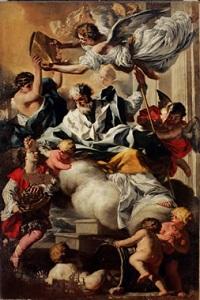 The Laboratorio della Soprintendenza at Cosenza also houses a group of canvasses by Mattia Preti from Taverna, the artist's birthplace. Examples of L. Giordano's work can be seen in Cosenza Cathedral and Diocesan Museum and in the Capuchin church at Vibo. Other artists include Solimena with a beautiful painting of Fiumefreddo Bruzio "San Nicola di Bari salva il fanciullo coppiere", De Musa (Serra San Bruno), and Salvator Rosa, Catanzaro Provincial Museum.
The Laboratorio della Soprintendenza at Cosenza also houses a group of canvasses by Mattia Preti from Taverna, the artist's birthplace. Examples of L. Giordano's work can be seen in Cosenza Cathedral and Diocesan Museum and in the Capuchin church at Vibo. Other artists include Solimena with a beautiful painting of Fiumefreddo Bruzio "San Nicola di Bari salva il fanciullo coppiere", De Musa (Serra San Bruno), and Salvator Rosa, Catanzaro Provincial Museum.
Calabria has always its own way, though following the Neapolitan school, the most active centre being Vibo, with artists such as Zosa, Mergolo, Rubino and Curatoli, closely followed by the town of Serra San Bruno, first belonging to the Fanzighiana school, later more indigenous with whole families of artists (the most famous were the Barillari).
Silk making at Catanzaro, provided the wall-hangings for Castelnuovo in Naples. Wood and stone-carving both thrived. The churches of the Addolorata at Serra San Bruno and the Immacolata in Catanzaro and San Giuseppe, at Crotone, reflect a sombre, sober style. This is true also of buildings in Filadelfia, San Nicola Arcella and Catanzaro ( De Nobili, La Russa). The centre of Filadelfia has characteristcs 18th century elliptical orthogonal lay out and centre square. Some fine examples of neo-classical architecture are found in Calabria, at Vico, Tropea ans Pizzo, particularly in Cosenza (the Rendano Theatre, Liceo Telesio and Casa Rendano).
Landscaping painting was a particularly popular art form, probably as a result of frequent visits by landscape painters to the Bourbon court inn the 18th and 19th centuries, amongst them Hackert and Pitloo, who stimulated local artists, Fieschi, Salazar, Benassi, Cefaly and Santoro.
Next page :Codex Purpureus
You might also be interested to learn about : Calabria Ethnic minorities | Calabria Grecanica | Traditions & Folklore | Costumes of Calabria | Traditions and Progress | A culture of skills | Art in Calabria | Archaelogy



 The small 10th or 11th century church of San Marco di Rossano has a rectangular vestibule and a large square place divided by six pillars. Three semi-circular apses and double arched windows complete the building.
The small 10th or 11th century church of San Marco di Rossano has a rectangular vestibule and a large square place divided by six pillars. Three semi-circular apses and double arched windows complete the building. Situated on a hill in the middle of the countryside, this latter church is a kind of early Christian Acropolis with architectural elements similar to those of Greek, Armenian and Anatolian churches.
Situated on a hill in the middle of the countryside, this latter church is a kind of early Christian Acropolis with architectural elements similar to those of Greek, Armenian and Anatolian churches. Of the 12th century objects, the most precious in the region is the Stauroteca, a reliquary of the Cross from the Swabian workshops in Palermo (c.1220) donated to Cosenza Cathedral by Frederick of Swabia, who was present at the consecration of the church. The cross is made of filagreed sheet gold with enamel and gemstones
Of the 12th century objects, the most precious in the region is the Stauroteca, a reliquary of the Cross from the Swabian workshops in Palermo (c.1220) donated to Cosenza Cathedral by Frederick of Swabia, who was present at the consecration of the church. The cross is made of filagreed sheet gold with enamel and gemstones Other small but beautiful churchus include Umbratico Cathedral, with its twelve-columned crypt and cross-vaulted ceiling, the church of S.Adriano and S Demetrio Corona ( Cosenza ), noted for its Italo-Albanian College, in the Sila Greca. The church has a mosaic floor and frescoes.
Other small but beautiful churchus include Umbratico Cathedral, with its twelve-columned crypt and cross-vaulted ceiling, the church of S.Adriano and S Demetrio Corona ( Cosenza ), noted for its Italo-Albanian College, in the Sila Greca. The church has a mosaic floor and frescoes. The greatest Norman building however, is Gerage Cathedral (Reggio di Calabria ), the biggest church in the region. Built in the form of a Latin cross, it measures 76 x 23 m and was consecrated in 1045.
The greatest Norman building however, is Gerage Cathedral (Reggio di Calabria ), the biggest church in the region. Built in the form of a Latin cross, it measures 76 x 23 m and was consecrated in 1045. important being the icon of the Madonna di Pilero (a copy, the original is in the Archbishop's palace ), a masterpice by Eastern goldsmiths, and the sarcophagus of Isabella of Aragon, wife of Philip III, who died in Cosenza while returning from the East. This sarcophagus was made in France by French craftsmen. The most outsting example of Gothic art in a religious building is to be found at Altomonte ( Cosenza ) in the church of Santa Maria della Consolazione, built in c.1330 by Filippo Sangineto, the feudal overlord.
important being the icon of the Madonna di Pilero (a copy, the original is in the Archbishop's palace ), a masterpice by Eastern goldsmiths, and the sarcophagus of Isabella of Aragon, wife of Philip III, who died in Cosenza while returning from the East. This sarcophagus was made in France by French craftsmen. The most outsting example of Gothic art in a religious building is to be found at Altomonte ( Cosenza ) in the church of Santa Maria della Consolazione, built in c.1330 by Filippo Sangineto, the feudal overlord. The S. Ladislao di Ungheria by Simone Martini , for centuries in Altomonte Cathedral, now in the Soprintendenza di Cosenza, was probably commissioned of the Sienese painter by Filippo Sangineto in 1326. Other paintings in the church are by B. Daddi and Ciccio da Mileto, a pupil of Antonello. Another monument a Tropea Cathedral, variously restored.
The S. Ladislao di Ungheria by Simone Martini , for centuries in Altomonte Cathedral, now in the Soprintendenza di Cosenza, was probably commissioned of the Sienese painter by Filippo Sangineto in 1326. Other paintings in the church are by B. Daddi and Ciccio da Mileto, a pupil of Antonello. Another monument a Tropea Cathedral, variously restored. The famous Pizzo Castle (Aragonese ), where Murat was shot, was built at a later date. Belvedere Marittima Castle ( Cosenza ) is also Aragonese and fairly conserved. In this period, local craftsmen began to carry out the work, drawing inspiration from models imported to into Italy, particularly Catalonian.
The famous Pizzo Castle (Aragonese ), where Murat was shot, was built at a later date. Belvedere Marittima Castle ( Cosenza ) is also Aragonese and fairly conserved. In this period, local craftsmen began to carry out the work, drawing inspiration from models imported to into Italy, particularly Catalonian. In Cosenza are the 16th century church of S. Chiara, annexed to the Library ( it has a dine wodden ceiling ), the church of the Virgins, with a tufa doorway, and decoration, the little church of S. Salvatore, with a triumphal arch dating to 1571 ( now the Albanian parish ) and the church of Madonna del Carmine with its convent, now the Carabinieri headquarters.
In Cosenza are the 16th century church of S. Chiara, annexed to the Library ( it has a dine wodden ceiling ), the church of the Virgins, with a tufa doorway, and decoration, the little church of S. Salvatore, with a triumphal arch dating to 1571 ( now the Albanian parish ) and the church of Madonna del Carmine with its convent, now the Carabinieri headquarters. Baroque, in the 17th century began to spread all over Italy, especially to Naples , here in rather ambiguous lines.The best examples are Vibo Cathedral, built over an old Byzantine church, to a plan at least partly designed by Curatoli; in San Giorgio Martire, at Pizzo, St Francis of Assisi at Cosenza ( the interior), the Oratorio del Rosario, at San Domenico (the church is 15th century), and in the oratory of the Congrega del Rosario, Catanzaro, one of the rarest and most artistic works of local craftsmen is a wodden series consisting of choir, cerimonial chair, two choir lofts; there are also stucco wall decorations.
Baroque, in the 17th century began to spread all over Italy, especially to Naples , here in rather ambiguous lines.The best examples are Vibo Cathedral, built over an old Byzantine church, to a plan at least partly designed by Curatoli; in San Giorgio Martire, at Pizzo, St Francis of Assisi at Cosenza ( the interior), the Oratorio del Rosario, at San Domenico (the church is 15th century), and in the oratory of the Congrega del Rosario, Catanzaro, one of the rarest and most artistic works of local craftsmen is a wodden series consisting of choir, cerimonial chair, two choir lofts; there are also stucco wall decorations. One of the best examples is the Montalto Uffugo Cathedral (Cosenza), with a sculptured limestone facade and portals elegantly carved by local sculptors, and wide flight of steps. The 16th century church of S. Francesco stands in the same square. The most striking example of the period is the Certosa di Serra San Bruno (Catanzaro) on the Ionian side of the Serre, in a splendid position. Founded by San Brunone in 1091, and restored inn the 16th century, it was destroyed by the earthquake of 1783. The facade and part of the 16th century cloisters still remain. It is said the Palladium designed the church. The visitor is impressed by the beauty of its site on alawn in the middle of woodland, at a heigth of 800 m, and by the facade resembling the background for a Spanish drama, calling to mind another, intact facade in Spain: Gaudi's Sacrada Familia (1900) in Barcellona.
One of the best examples is the Montalto Uffugo Cathedral (Cosenza), with a sculptured limestone facade and portals elegantly carved by local sculptors, and wide flight of steps. The 16th century church of S. Francesco stands in the same square. The most striking example of the period is the Certosa di Serra San Bruno (Catanzaro) on the Ionian side of the Serre, in a splendid position. Founded by San Brunone in 1091, and restored inn the 16th century, it was destroyed by the earthquake of 1783. The facade and part of the 16th century cloisters still remain. It is said the Palladium designed the church. The visitor is impressed by the beauty of its site on alawn in the middle of woodland, at a heigth of 800 m, and by the facade resembling the background for a Spanish drama, calling to mind another, intact facade in Spain: Gaudi's Sacrada Familia (1900) in Barcellona.  Close by stands the new monastery. Some 3 km further on, along a fir-lined road, lies the little church of Santa Maria del Bosco, where San Brunone died, the big hollow boulder (restored) where the saint prayed, and a small lake with a statue of San Brunone at prayer in the water. Legend has it that when his bones were being moved, a spring gushed forth. In the 16th century, the Gaginis, Sicilian sculptors and the Mazolas from Tuscany, were very active here.
Close by stands the new monastery. Some 3 km further on, along a fir-lined road, lies the little church of Santa Maria del Bosco, where San Brunone died, the big hollow boulder (restored) where the saint prayed, and a small lake with a statue of San Brunone at prayer in the water. Legend has it that when his bones were being moved, a spring gushed forth. In the 16th century, the Gaginis, Sicilian sculptors and the Mazolas from Tuscany, were very active here. rom the 17th to the 19th century: Painting in Calabria was prevalently influenced by Mannerism, and this is the style found in the Madonna of Ognissanti (from Stilo Cathedral), now at the Laboratorio di Conservasione della Soprintendenza at Battistello Caracciolo (Cosenza); the Ecce Homo in Paola Basilica and the Madonna with Child in Glory in Catanzaro Provincial Museum.
rom the 17th to the 19th century: Painting in Calabria was prevalently influenced by Mannerism, and this is the style found in the Madonna of Ognissanti (from Stilo Cathedral), now at the Laboratorio di Conservasione della Soprintendenza at Battistello Caracciolo (Cosenza); the Ecce Homo in Paola Basilica and the Madonna with Child in Glory in Catanzaro Provincial Museum.  The Laboratorio della Soprintendenza at Cosenza also houses a group of canvasses by Mattia Preti from Taverna, the artist's birthplace. Examples of L. Giordano's work can be seen in Cosenza Cathedral and Diocesan Museum and in the Capuchin church at Vibo.
The Laboratorio della Soprintendenza at Cosenza also houses a group of canvasses by Mattia Preti from Taverna, the artist's birthplace. Examples of L. Giordano's work can be seen in Cosenza Cathedral and Diocesan Museum and in the Capuchin church at Vibo. 